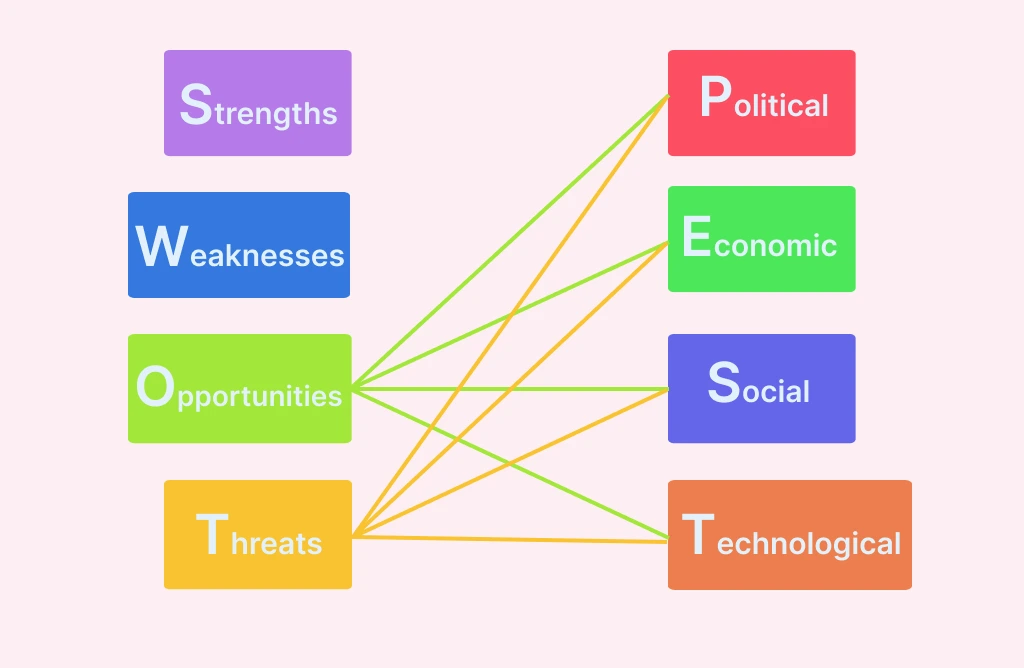When planning a project, it is important to learn about the internal and external environmental factors that can affect the project. There are some excellent strategic planning methods that you can use to analyze all these factors. PEST analysis and SWOT analysis are two of the most frequently used planning methods. Below is a brief introduction to both methods, how to use Creately’s AI templates to perform each analysis and a comparison of the two.
What is PEST Analysis?
A PEST is an analysis used to evaluate the external environment that can impact a business, project, or industry. It looks at Political, Economic, Social, and Technological factors.
Political: Government policies, regulations, trade restrictions, tax policies, and political stability.
Economic: Inflation, interest rates, employment levels, consumer confidence, and economic cycles.
Social: Demographics, cultural trends, lifestyle changes, education levels, and social attitudes.
Technological: Innovation, automation, R&D activity, technological change, and adoption rates.
When to use a PEST Analysis?
Strategic Planning or Business Expansion
Use a PEST analysis when entering new markets or regions—especially globally—to evaluate external risks and opportunities. It helps assess country-specific regulations, political climate, and economic stability before committing resources.
Launching a New Product or Service
Assess trends (e.g., regulatory changes, tech adoption) that may affect success or timing. PEST highlights emerging technologies, shifts in consumer behavior, or legal restrictions that could impact your go-to-market strategy.
Market Research & Opportunity Assessment
Evaluate the long-term viability and forces shaping customer behavior or industry evolution. A PEST helps identify demand drivers or barriers (e.g., social movements or economic downturns) before investing in new opportunities.
Scenario Planning & Risk Management
Identify external threats (e.g., inflation, policy shifts, digital disruption) that could derail business continuity. It prepares your team to create backup plans for uncontrollable external forces by proactively analyzing potential disruptions.
Organizational Restructuring or Investment Decisions
Understand external influences that may affect organizational direction, funding, or partnerships. A PEST analysis can reveal changes in tax laws, labor policies, or global financial conditions that impact internal restructuring or M&A plans.
Competitor and Industry Analysis
Gain context around why competitors may thrive or struggle in specific external environments. By understanding how macro factors affect the entire industry, you can benchmark your position and build a competitive edge.
What is SWOT Analysis?
SWOT analysis is a strategic planning tool used to assess an organization’s Strengths, Weaknesses, Opportunities, and Threats. It helps businesses, teams, and individuals make informed decisions by evaluating internal and external factors that impact success.
Strengths: Internal attributes that give you an advantage (e.g., brand reputation, skilled workforce, proprietary tech).
Weaknesses: Internal limitations or areas that need improvement (e.g., lack of resources, skill gaps, outdated systems).
Opportunities: External trends or conditions you can leverage for growth (e.g., emerging markets, tech advancements).
Threats: External risks that could harm your performance (e.g., new competitors, regulatory changes, economic downturns).
When to use a SWOT Analysis?
Strategic Planning
Use SWOT to align your business goals with your internal capabilities and external opportunities or threats. It provides a clear roadmap for setting priorities and allocating resources effectively.
Launching a New Product or Service
Identify internal strengths (e.g., unique features) and weaknesses (e.g., limited budget), and assess market conditions. SWOT helps validate whether you’re ready to launch or need to improve before going to market.
Entering a New Market or Region
Evaluate how your organization’s strengths and weaknesses match up with new market dynamics. SWOT analysis is useful for assessing fit and identifying local challenges or competitive threats.
Evaluating a Business Idea or Investment
Test the feasibility of a business idea by examining internal readiness and external market potential. SWOT ensures you’re not moving forward based on assumptions, but on well-structured insight.
Competitor Benchmarking
Compare your strengths and weaknesses against a specific competitor or market leader using a SWOT analysis. This enables informed positioning and helps refine your unique value proposition.
Performance Reviews or Business Audits
Use SWOT to reflect on what’s working and what needs improvement in your team, department, or business. This helps surface hidden blockers or unused assets in current operations.
Crisis Management or Risk Planning
Identify vulnerabilities and potential external threats to prepare proactive response strategies. A SWOT analysis can guide pivot decisions and reinforce business continuity planning.
Comparison of PEST and SWOT Analysis
Both PEST analysis and SWOT analysis are strategic tools used for business planning, but they focus on different aspects.
| Feature | PEST Analysis | SWOT Analysis |
|---|---|---|
| Focus | External macro-environmental factors | Internal strengths and weaknesses, plus external opportunities and threats |
| Purpose | Helps businesses understand external influences like political, economic, social, and technological factors | Assesses a company’s competitive position and strategic direction |
| Scope | Broader perspective, analyzing industry trends and market conditions | More specific to the organization’s internal capabilities and external risks |
| Use Case | Ideal for market research, industry analysis, and long-term planning | Best for business strategy, competitive analysis, and decision-making |

How PEST SWOT Complement Each Other
Directly comparing SWOT vs PEST is probably the wrong thing to do. They are both planning methods that give tremendous insights for you to successfully execute projects.
The disadvantage of PEST or PESTLE analysis is it doesn’t consider the internal factors of your organization. It deeply analyzes the external factors that might affect your project or organization. So if you plan your projects based only on the PEST analysis, you will not have any insights to match your strengths to a current need.
SWOT analysis considers both the internal and external factors. It captures the external factors in the opportunities and threats section. However, when creating a SWOT diagram, a deep analysis of external factors is not performed, at least not as extensively as a PEST analysis. So you might miss out on external factors that can benefit your project.
The best way then is to utilize both PEST and SWOT analysis methods when trying to understand factors that affect your business.
Using AI to Create A PEST and SWOT Analysis
Completing a thorough PEST and SWOT analysis is made even more effortless with Creately’s AI-powered templates. It’s as easy as selecting the AI PEST or SWOT Analysis template from the library, entering a simple description of your business as a prompt and clicking the ‘Generate’ button. Creately will handle the template creation according to a standard PEST or SWOT framework and fill in the relevant sections based on your input. Select one of the templates below, skip the manual data gathering, and jump straight to your business insights today!
How to Do a PEST Analysis in Creately
A PEST analysis is done by gathering insights in each of the four categories (Political, Economic, Social, and Technological), analyzing their implications, and deciding if they present risks or opportunities. Here’s a detailed breakdown of how to conduct a PEST Analysis in Creately.
Step 1: Select the PEST Analysis Template
Open Creately, browse our collection of PEST analysis templates and select one that works for you. You can find blank templates, and ones with details already filled in to help beginners.
Step 2: Fill the PEST Analysis
Gather relevant details about your industry, market, or business environment and start filling the Political, Economic, Social, and Technological factors in the PEST template.
Step 3: Refine & Organize
Review each section carefully and refine the content to ensure accuracy. Add or remove factors based on your specific business needs. Drag and drop elements to prioritize key drivers affecting your business. Use color codes, tags, or connectors to group related factors. Arrange insights in a logical flow to make analysis easier.
Step 4: Collaborate in Real-Time
Share the analysis with your team in real-time using Creately’s collaborative workspace. Invite members to contribute comments, suggestions, and annotations to refine insights. Work together to identify actionable strategies based on the analysis.
Step 5: Expand to PESTLE
If needed, extend the analysis to include Legal and Environmental factors. Evaluate how regulations, sustainability, and ecological trends impact your business. Use Creately’s tools to integrate additional frameworks like SWOT Analysis for deeper insights.
Legal: Consumer protection laws that ensure fair treatment of customers, employment laws that cover governing wages, working conditions, and employee rights, IP laws for copyright, patents, and trademarks, and Health & Safety Regulations need to be considered.
Environmental: Climate change policies aimed at reducing carbon footprints, laws covering waste disposal practices, access to raw materials, and government incentives for businesses adopting sustainable energy sources. Natural disasters risks posed by floods, hurricanes, or droughts affecting supply chains are important as well.
Step 6: Export and Share Analysis
Once finalized, export your PEST analysis in JPEG, PNG, PDF, or SVG formats and use built-in tools to create presentations. Enable link sharing to embed the analysis on websites or share with stakeholders. Manage access levels to control who can view or edit the document.
How to Do a SWOT Analysis in Creately
Step 1: Select the SWOT Analysis Template
Open Creately, browse our collection of SWOT analysis templates and select one that works for you. Some of the templates will have details already filled in to help beginners while blank templates are also available to begin fresh.
Step 2: Fill the SWOT Analysis
Gather relevant details about your business’ Strengths, Weaknesses, Opportunities, and Threats and start filling in the template.
Step 3: Refine & Review
Carefully examine each section and adjust the content to maintain relevancy. Modify the factors to align with your specific business requirements. Organize key elements by dragging and repositioning them on the template. Apply color codes, tags, or connectors to visually categorize according to themes. Structure the insights in a coherent and logical manner for better clarity and analysis.
Step 4: Invite Your Team for Collaboration
Work alongside your team instantly using Creately’s real-time interactive workspace. Invite members to share feedback through comments, suggestions, and annotations to enhance gathered insights. Discuss, refine your analysis together and vote on actionable strategies to move forward.
Step 5: Export and Share
After completing your SWOT analysis, utilize built-in features to generate presentations effortlessly or export it in various formats such as JPEG, PNG, PDF, or SVG for easy accessibility. Activate link sharing to embed your analysis online or distribute it to key stakeholders. Adjust access settings to control viewing and editing permissions.
More PEST and SWOT Analysis Templates By Creately
Helpful Resources for PEST and SWOT Analysis
A practical guide to understanding how to perform a SWOT analysis for your business.
Use this AI-powered tool to speed up your PEST analysis.
A list of real-world SWOT analysis examples and useful templates.
Browse our collection of ready-to-use PEST analysis templates.
Conclusion
The results which have been recorded on your Creately PEST and SWOT analysis templates can then be used to plan a project carefully and overcome problems which could cause significant issues to the positive outcome of the project. Being prepared for all eventualities is vital in business, which is why PEST and SWOT analysis is so important.
Remember it is never enough to simply have the information to hand, what is vital is the way that the analysis is used in order to boost profits, make sure a project is successful and to identify areas of opportunity which could transform the business for the better.
FAQs about PEST and SWOT Analysis
How is PEST analysis useful?
What is the difference between PEST and PESTLE analysis?
When should I use PEST analysis?
How does SWOT analysis help businesses?
What is the difference between SWOT and PEST analysis?
Can SWOT analysis be used for personal development?
Resources
Carruthers, H. (2009). Using PEST Analysis to Improve Business Performance. In Practice, 31(1), pp.37–39. doi:https://doi.org/10.1136/inpract.31.1.37.
Leigh, D. (2009). SWOT Analysis. Handbook of Improving Performance in the Workplace: Volumes 1-3, [online] 1-3(2), pp.115–140. doi:https://doi.org/10.1002/9780470592663.ch24.
Puyt, R., Lie, F.B., De Graaf, F.J. and Wilderom, C.P.M. (2020). Origins of SWOT Analysis. Academy of Management Proceedings, [online] 2020(1). Available at: https://journals.aom.org/doi/abs/10.5465/AMBPP.2020.132.






